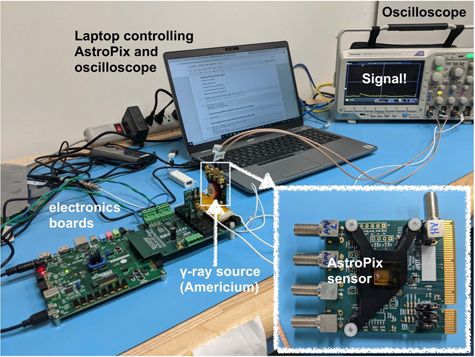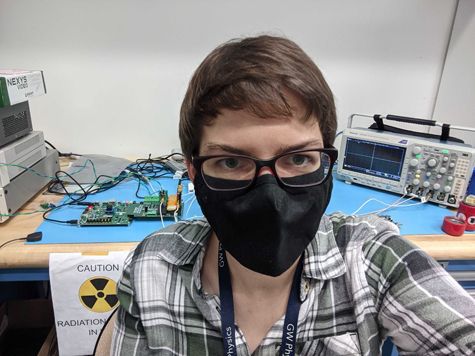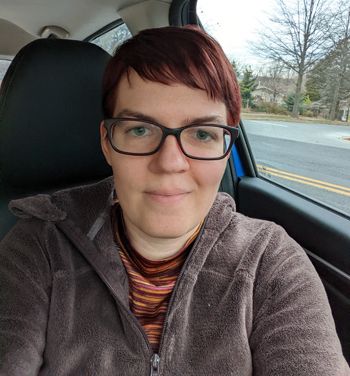Early Career Scientist Spotlight
Dr. Henrike Fleischhack (she/her/hers)
Gamma-ray Astronomer
Astroparticle Physics Laboratory (661)
What inspired you to pursue a career in gamma-ray astrophysics?
I became interested in science fiction as a teenager and decided I really wanted to go into research later. I liked both Math and Physics in high school and decided to major in Physics as an undergrad because it seemed more exciting and relevant to me (at the time!). I ended up working in particle physics for my bachelor’s and master’s theses, because I was intrigued by the particle physics lectures I attended. However, I wanted to try something different for my PhD. I signed up for a lab tour at the research center DESY Zeuthen and ended up doing my PhD with a gamma-ray astronomy group there, working on the ground-based VERITAS (Very Energetic Radiation Imaging Telescope Array system) gamma-ray telescope. I really enjoyed working on VERITAS and have stayed true to gamma-ray astronomy ever since. My background in particle physics has been quite helpful at times, too!
What science questions do you investigate?
I work in gamma-ray astronomy and instrumentation. Broadly, I am interested in studying gamma-ray sources such as supernova remnants and gamma-ray bursts, characterizing their energy spectra and light curves and comparing to theoretical models to figure out what makes them “tick”. Which processes produce the gamma-ray emission? In the last year, I have contributed to the design of the proposed medium-energy gamma-ray astronomy mission AMEGO-X (All-Sky Medium Energy Gamma-ray Observatory eXplorer). I performed simulations of how gamma rays (our “signal”) and cosmic rays (our “background”) would interact in the detector and what kind of signature they would produce. I used these simulations to characterize the predicted performance of AMEGO-X, and to help optimize certain detector design choices. Recently, I started working on the characterization and calibration of a prototype of the silicon sensor chip (AstroPix) to be used in the tracker of the AMEGO-X instrument. I also contribute to the analysis of data from existing gamma-ray missions.
What does a typical day at work look like for you?
Most of the time, I will be in front of my laptop: running simulations, analyzing, visualizing, and documenting simulation results and AstroPix measurements, as well as preparing for, participating in, and running telecons, and exchanging results and coordinating plans with collaborators on AMEGO-X and AstroPix. Occasionally, I will be in the lab, troubleshooting AstroPix or setting up measurements with radioactive gamma-ray sources. I work from home a few days a week and was in fact fully remote for my first year at Goddard (July 2020 – July 2021).

Credit: H. Fleischhack
Tell us about one project that has been particularly impactful in your field.
During my time as a post-doc at Michigan Technological University working with the HAWC (High-Altitude Water Cherenkov Observatory) collaboration, I prepared and published 3HWC, the third HAWC catalog of Very-high-energy gamma-ray sources (with two other main authors, and support from the HAWC collaboration). HAWC is a ground-based detector for TeV gamma-ray astronomy, located in Mexico, and continuously surveys the northern gamma-ray sky as it passes overhead. The third HAWC catalog was based on about 4 years of data and comprises 65 TeV gamma-ray sources, which we characterized in terms of position on the sky, extent, energy spectrum, and flux level. Most of these gamma-ray sources are located within our Galaxy and many are related to the acceleration of charged particles (cosmic rays) by the remnants of gigantic supernova explosions. Combining measurements in many wavelengths (e.g., X-rays, gamma-rays, radio) is necessary to study the powerful processes leading to the particle acceleration. TeV gamma-ray emission, in particular, helps constrain the maximum energy up to which particles can be accelerated in a given source.
If you were to expand your current research focus, what new topics would you explore?
Space-based gamma-ray instrumentation and medium-energy gamma-ray astronomy are actually still new to me, as I mainly worked with ground-based gamma-ray instruments that detect very-high-energy gamma rays before I started at Goddard. Because of this, I’m still learning about what kind of exciting science can be done with MeV gamma-ray observations. If I wanted to further expand my research focus, I would probably lean towards going deeper into the instrumentation side and look into ways to improve our detectors, readout electronics etc.
What early career advice do you have for those looking to do what you do?
I would encourage people to move around a bit, maybe change fields or look for new challenges, and figure out what kind of environment you like to work in. Also, get a Bluetooth headset or wireless headphones for telecons!

Credit: H. Fleischhack
What is a fun fact about you?
I joined a student theater group when I was an exchange student in Uppsala, Sweden. There is video of me singing and performing in various languages!
Biography
Home Town:
Oldenburg (Oldb), Germany
Undergraduate Degree:
Bachelor of Science in Physics, Georg-August Universität Göttingen (Germany)
Post-graduate Degrees:
Master of Science in Physics, Georg-August Universität Göttingen (Germany)
Doctorate of Natural Sciences (PhD) in Physics, Humboldt Universität Berlin (Germany) and DESY Zeuthen (Germany)

Link to Dr. Fleischhack's GSFC Bio
